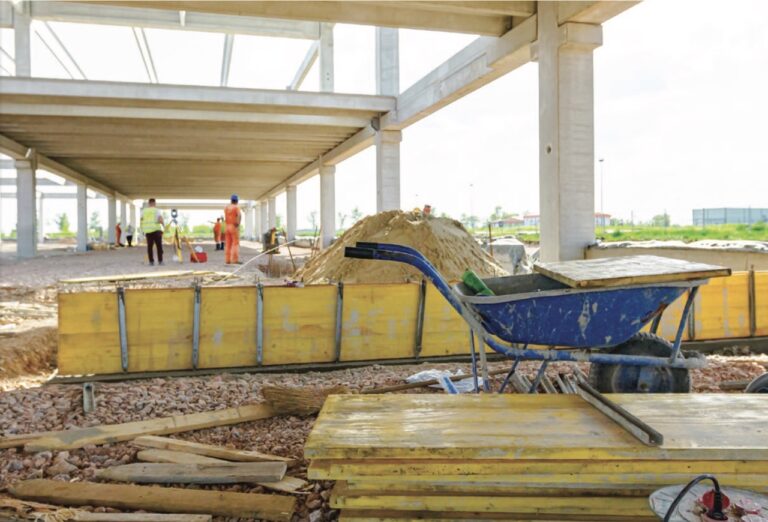WHAT DOES THE FUTURE HOLD?
Checking up on backlog: the industry’s and yours
Owners of successful construction companies can usually predict the future. It’s not because they have magical powers. No, strongly per- forming businesses typically have a healthy backlog of projects in the pipeline, with contracts signed and schedules laid out.
By the same token, the construction industry as a whole can forecast where economic trends are heading by, among other things, tracking how strong or weak backlog is nationwide. As of this writing, for instance, commercial contractors are cautiously optimistic about sales, profit margins and staffing levels over the coming months — in part because of encouraging backlog numbers.
It all adds up to one simple truth: By checking up on backlog, both the industry’s and yours, you’ll be able to better adjust your financial management practices to the opportunities and challenges that lie ahead.
Recent example
According to the industry trade association Associated Builders and Contractors (ABC), nonresidential contractor confidence has been ticking upward as backlogs have stabilized. These construction business owners have expressed this confidence while also recognizing that the U.S. Federal Reserve may continue to increase interest rates to combat inflation.
In September 2022, for example, the ABC’s Construction Backlog Indicator reported that the backlog of work won but not yet started had grown to 9.0 months from 8.7 months in August. That figure was higher than at any point from February 2020 to March 2022. ABC found that many nonresidential contractors were operating at capacity, with few signs of faltering demand.
Of course, promising industry numbers are subject to change and no guarantee that your business will have a healthy backlog. If yours is dwindling or nonexistent, it might indicate that competition is increasing in your market and/or your reputation is suffering.
A large backlog is generally considered healthy, but there’s a breaking point. Maintaining too big of a backlog might signal a future decline in client satisfaction because completion deadlines will get pushed further and further out. It also could be a sign that you’re underbidding.
5 tactics to consider
Backlog management is all about finding the proper balance between growing your book of business, keeping current clients satisfied, and maintaining or widening your profit mar- gins. Here are five tactics to consider:
1. Adjust your approach to bidding. Resist the temptation to bid for every project that comes along simply to build your backlog. Bid only on jobs that you’re suited for, are likely to win and hold promise of solid profits.
LEVERAGE DATA TO BETTER MANAGE BACKLOG
Over the years, a wide range of industries have come to see the value of intensive data analysis. However, many construction businesses — especially smaller, closely held ones — have yet to fully get onboard. Backlog management is one of the many areas where analytics can prove particu- larly valuable.
Odds are, you’re already sitting on a mountain of information that you can use to better track and manage backlog and potentially increase profit margins. The easiest approach is to identify key performance indicators (KPIs), such as annual revenue, annual gross profit percentage and monthly return on scarce resources. By calculating such KPIs for past projects, you can better target the types of jobs most likely to be profitable.
The KPIs could, for example, show that certain contract-value segments or project types have given your bottom line the biggest boost. Conversely, they can highlight the kinds of jobs that generally haven’t paid high premiums or perhaps have even cost you money. Obviously, you should avoid these going forward.
Biting off more than you can chew can under- mine cash flow and leave you without the funds needed to pay bills and service debt. You could end up damaging both your reputation and credit standing.
2. Tailor your workforce to backlog. It’s vital to match your staffing level to realistic expectations regarding upcoming projects. Maintaining too high of a payroll when jobs will likely become scarce will tie up substantial funds in idle workers.
A large backlog is generally considered healthy, but there’s a breaking point.
On the other hand, overextending a minimal workforce can lead to injuries, workers’ comp claims, delays, poor employee retention and trou- ble hiring quality workers. Find the right balance based on your backlog and strategic objectives.
3. Maintain strong client communications. Be upfront with clients about scheduling based on an honest assessment of your backlog. Misleading them will only create frustration, disappointment and bad word of mouth.
That said, your backlog is your business — literally and figuratively. You don’t have to go into too many details. Rather, reassure clients by sharing and reiterating plans and timelines for their respective projects.
4. Nurture relationships with everyone. As you communicate with clients, strive to build lasting relationships. And use this same approach with everyone else involved in your jobs — including developers, engineers and inspectors. Having friendly, collaborative relationships can buy you valuable time when dealing with problems and give you helpful leads on future projects.
5. Monitor conditions. Keep tabs on the national, state and local economies; the industry in general (such as ABC’s backlog data); and your local construction market. Staying on top of trends and developing stories can help you seize opportuni- ties and prepare for downturns.
Backlog … to the future
It’s a funny word, “backlog.” One might think it refers to the past, but your backlog is really an intended path into the future. It’s also vital to ensur- ing consistent cash flow and continuing profitability. Your CPA can help you integrate managing your backlog with cash-flow and tax planning.
HOW TO UP YOUR FINANCIAL REPORTING GAME
The success of most construction businesses is built on not only quality work, but also positive relationships. Obviously, you’ve got to work well with project owners. But you need a solid rapport with other entities as well — including lenders, sureties and other stakeholders.
One way to enhance these relationships is to consistently generate complete, accurate and timely financial statements and other documen- tation. Here are some ways to up your financial reporting game.
Generate best-in-class financial statements
This may seem obvious, but sloppy financial report- ing is a big red flag for financial statement users. Regardless of your company’s financial health, lenders and sureties will hesitate to extend credit unless your statements are complete, accurate and timely. And that also goes for additional docu- mentation such as work-in-progress (WIP) schedules and owners’ personal financial statements.
Don’t view financial reporting as only a once-a-year activity. Dedicate yourself to preparing high-quality interim financial statements throughout the year — preferably those that adhere to Generally Accepted Accounting Principles. Lenders and sureties hate surprises; solid monthly or quarterly financial reporting will minimize the need for year-end adjustments.
Compare and contrast
Compare current financial statements to previous years’ statements as well as to industry data from comparable companies. Benchmarking against your own results can reveal trends in financial performance over the years — both positive and negative — and reveal potential reporting errors. You may discover opportunities to improve your financial reporting as well as to reduce debt, speed-up col- lections, or correct a pattern of under- or overbilling.
Benchmarking against industry data lets you see how your financial statements and key performance indicators stack up against the competition. Compare key ratios — such as debt-to-equity, return on equity, working capital turnover and current ratio (current assets to current liabilities) — to those of construction businesses of similar type and size in your geographic region. Benchmarking can serve as an early warning system that enables you to address financial weaknesses before it’s too late.
Maintain liquidity
It’s not enough to be profitable on paper or have a healthy net worth. Financial statement users also want to see solid working capital and a strong cash position, which reflects your ability to fund current operations.
Working capital is defined as current assets minus current liabilities. Current assets include cash and assets readily converted into cash — such as short- term receivables and certain inventory — in contrast to illiquid assets, such as buildings and equipment.
In assessing working capital, lenders and sureties usually discount riskier assets, such as old or related- party receivables or prepaid expenses.
There are many strategies for improving working capital. Examples include accelerating the col- lection of receivables, negotiating more favorable payment terms with vendors and suppliers, and refinancing short-term debt with long-term debt.
Track work in progress
Among the most important documents for lend- ers and sureties is the WIP schedule, which tracks contract price (adjusted for change orders), costs incurred to date, estimated job costs, estimated gross profits, revenues recognized, percentage of completion, billings to date and other information for ongoing jobs.
Preparing and analyzing periodic WIP schedules can help you spot problems and address them before they can escalate. For example, a WIP schedule may reveal jobs are underbilled, which could signal lax billing practices, cost overruns, management inefficiencies or an unhealthy num- ber of unapproved change orders.
Reviewing and comparing WIP schedules and completed contract schedules over time can also uncover unhealthy trends such as profit fade — that is, gross profits that decline over the life of a project. Profit fade is a red flag for lenders and sureties, so it’s important to address promptly. Potential strategies include improving estimating practices (or using more conservative estimates) and fine-tuning pro- cedures for managing change orders.
Winning ways
Sound, trustworthy financial reporting can mean the difference in getting the funding and bonding you need to grow your construction business. Your CPA can help you identify winning ways to raise your game to the highest level.
CHIPS ACT OFFERS OPPORTUNITIES AND CHALLENGES
Semiconductor chips are essential components of many electronic devices. These include smartphones, laptops, planes, electric vehicles and advanced medical diagnostic equip- ment. Chip shortages, caused at least in part by the pandemic’s impact on global supply chains, revealed the need for more domestic manufactur- ing of these items in the United States.
In August 2022, the Creating Helpful Incentives to Produce Semiconductors and Science (CHIPS) Act was signed into law. Mainstream news coverage has mostly focused on how the CHIPS Act will pro- vide $52.7 billion in federal funding to private proj- ects that strengthen the domestic semiconductor industry, create skilled manufacturing jobs and promote innovation. However, what hasn’t been discussed quite as much is the impact the law will have on the construction industry.
More projects in the pipeline
The CHIPS Act is expected to spur new long- term construction jobs. The U.S. Department of Commerce’s CHIPS for America Fund objectives go beyond supporting construction of a few massive semiconductor projects to also focus on the development of regional clusters of man- ufacturing plants and supplier facilities, as well as research and development and workforce development programs. This could help keep the construction sector on even footing even as the economy grapples with rising inflation.
In addition, the law establishes a new Advanced Manufacturing Facility Investment Credit on capital expenditures, which should generate significant additional private investment in such projects. The 25% investment tax credit will provide a direct-pay, refundable credit for installing facilities with a primary purpose of making semiconductors or semiconduc- tor manufacturing equipment.
Supporting infrastructure for all these facilities will be needed, too. That should mean even broader economic development. Indeed, communities across the country are already approving projects to build and improve roads, water infrastructure and new buildings to pave the way for new semi- conductor facilities. These include those in Arizona, New Mexico, Ohio and Texas.
Workforce challenges
Building such facilities will
likely require a construction company to have the appro- priate skillset and preferably some experience in building semiconductor plants or sim- ilar manufacturing facilities. Project teams will need to per- form specialized design and construction services suited to the clean building environ- ment, and security clearances may be required. Access to a skilled workforce with security clearance could be difficult
in a market already struggling with labor shortages.
Plus, federal Davis-Bacon requirements will apply to CHIPS-funded construction projects, which means workers must be paid local prevailing wages. Those requirements might put many smaller contractors at a competitive disadvan- tage when bidding, as well as limit the ability of some otherwise qualified and skilled workers and apprentices from participating in these jobs.
Access to a skilled workforce with security clearance could be difficult in a market already struggling with labor shortages.
What’s next
It’s been estimated that about $33 billion in semi- conductor fabrication plants are in the planning stages. As of this writing, with the CHIPS Act firmly signed into law, several large manufacturing- related projects are already moving forward to the construction stage. These include Intel’s new $20-billion facility in Ohio and GlobalFoundries’ expansion of a chip factory in New York.
The Commerce Department intends to continue issuing details about eligibility for funding as well as evaluation and selection criteria for proposals. To stay updated, visit CHIPS.gov.
4 WAYS TO WISE UP TO SMART BUILDINGS
Nowadays everything is “smart,” from phones to watches to appli- ances to, well, buildings. In a smart building, major systems — such as HVAC, lighting and security — are integrated under a single managed network infrastructure that’s con- nected to the Internet.
Increasingly, more structures are being built or ret- rofitted to include this technology to boost efficien- cies, improve occupant health and well-being, and enhance the tenant experience. But maybe you knew all of this. The question is: How can contrac- tors prepare for smart buildings from a construction perspective? Here are four ways to wise up:
1. Expect connectivity. Smart buildings require a robust network to connect users with the building systems themselves as well as with the equipment and devices they use in their work and/or daily lives. Where wiring is installed and smart objects, such as sensors, are embedded can affect performance. Many smart objects will be mapped out. Plan for Ethernet cable and AC power outlet placement near doors, windows, appliances and other access points. You may have to install or otherwise deal with 5G small cells throughout the property.
2. Select or recommend green materials and design elements. Sustainability and
energy efficiency lie at the core of smart buildings. Green elements include low-carbon concrete and green roof soil systems. It’s a good idea to stay on top of building material innovations, as new materials are being engineered to be smarter, stronger and more eco- friendly. Also, many smart buildings are designed to meet the criteria for green building certification, such as Leadership in Energy and Environmental Design (LEED).
3. Buy in to building information modeling (BIM).
As you’re no doubt aware by now, BIM uses specialized software to design a 3D model that displays both the functional and physical charac- teristics of a structure — including underground assets. BIM centralizes all project data, allowing for an integrated approach across disciplines to avoid conflicts, reduce construction waste and keep everybody on the same page.
Widely used for the planning and design of smart buildings, the BIM model also can be used during the construction phase and then turned over to the building owner as a “handbook” for operation and maintenance. The model will contain data on all building elements and their locations, which can include smart objects and network cables. Many experts believe BIM technologies allow the best use of smart-building data.
4. Consult specialists. A contractor is often tasked with installing many of a smart building’s devices. These can include smart locks, badge readers, keypads, smart thermostats, parking lot cameras, video intercoms and technology-powered pack- age rooms. In some cases, you may need to con- sult with a smart- or green-building technology specialist about how to identify and optimally install these devices.






